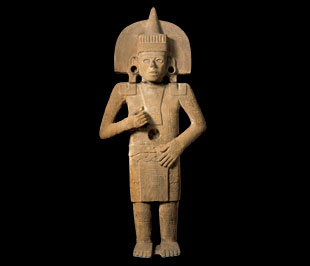|
























|
|









Apotheosis
The Aztecs conquered the Huaxtec region of the Gulf Coast of Mexico sometime after 1458. The Huaxtec people, who were related to the Maya, had their own ancient traditions and culture. They dressed in a distinctive manner, including the wearing of conical hats, and Huaxtec monumental stone sculpture influenced that of the Aztecs. This magnificent work exemplifies the dualism that permeated the artistic traditions of both cultures.
On one side, a male figure is depicted wearing a conical hat, large earspools, and a skirt tied around his waist, while the other side is dominated by a dramatic skeletal figure with feet ending in claws. Densely patterned designs, including ears of corn and feline heads, cover much of the body and most likely represent tattooing. While the recessed eyes and earspools probably held inlays, the deep depression at the navel, the symbolic heart of the figure, was probably used for ritual offerings. The fingers of the raised right hand once held a staff or banner. The figure has been variously interpreted as a cult statue to the god Quetzalcoatl or as a representation of a Huaxtec ruler.
Life-death figure (apotheosis). Huaxtec, ca. 900–1250. Stone, 158 x 67 x 22.9 cm. Brooklyn Museum, New York, Henry L. Batterman Fund and the Frank Sherman Benson Fund.
|
|